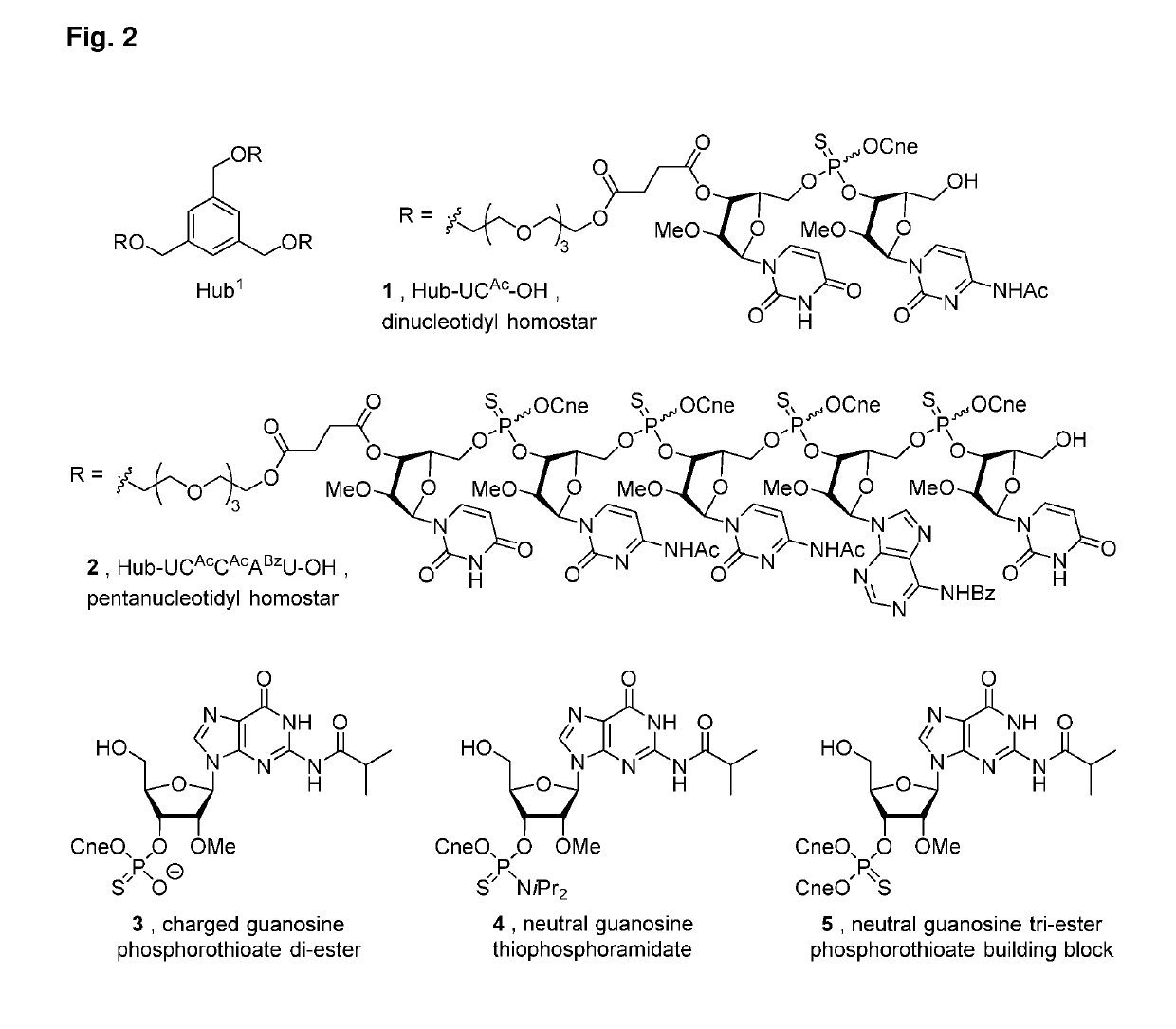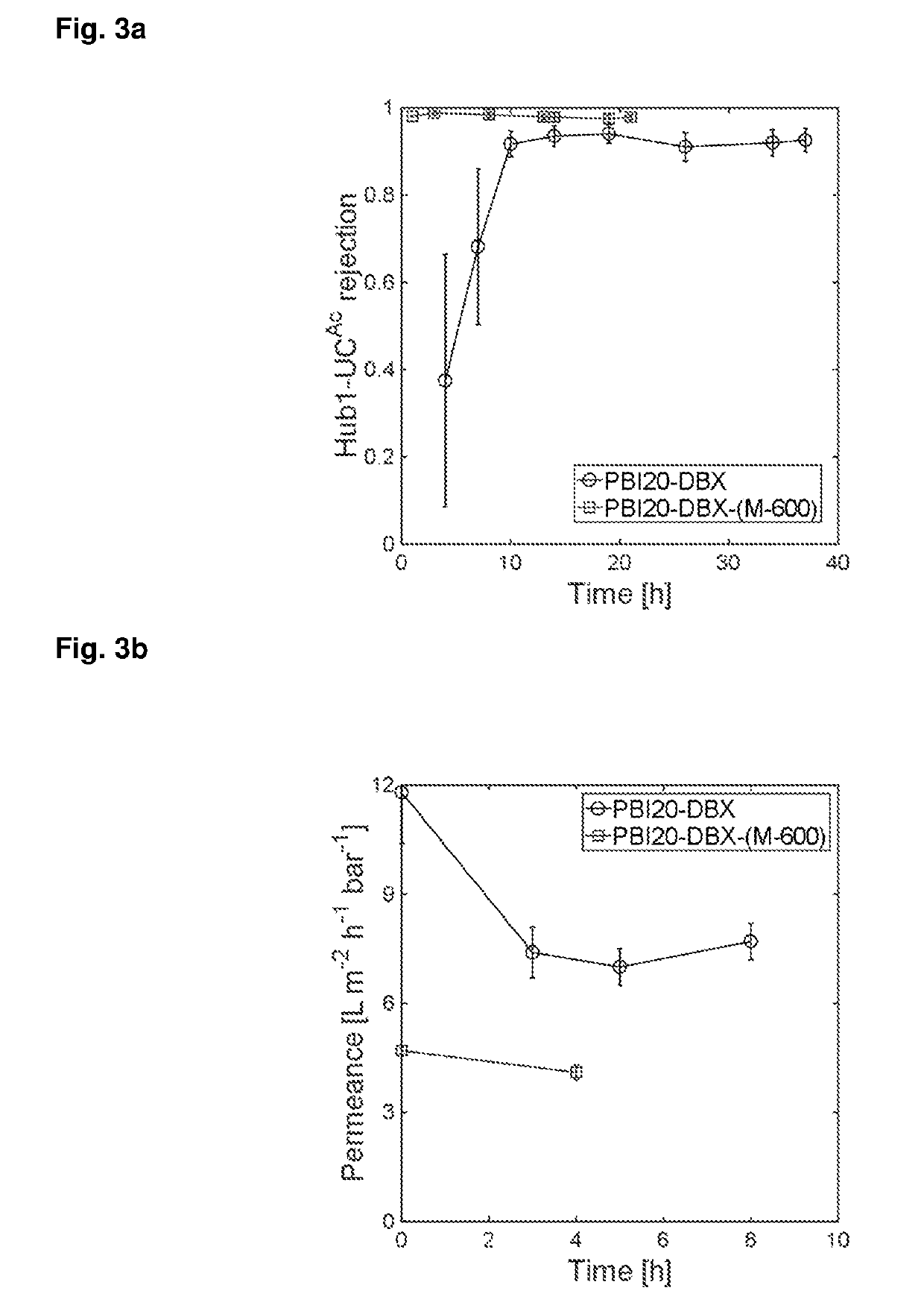Process for the production of solvent stable polymeric membranes
a polymer membrane and solvent stable technology, applied in membrane technology, membrane filtration, reverse osmosis, etc., can solve the problems of increasing the brittleness of the membrane, difficult manufacture and use, and not widely applied to the separation of solutes in organic solvents, and achieves the effect of higher permean
- Summary
- Abstract
- Description
- Claims
- Application Information
AI Technical Summary
Benefits of technology
Problems solved by technology
Method used
Image
Examples
example 1
[0233]The membrane performance was determined by filtration experiments. A laboratory scale cross-flow nanofiltration unit was used with 4 cross-flow cells in series. Membrane discs of active area 14 cm2 were used. An 80 mL feed tank was charged with a feed solution consisting of 0.04 g of tris(dinucleotidyl)hub1 homostar 1 (see FIG. 2). The feed solution was re-circulated at a flow rate of 60-180 L h−1 using a Micropump (GD series, Michael Smith Engineers Ltd., UK). Pressure in the cells was generated using a backpressure regulator which was located down-stream of a pressure gauge. During start-up, the non-reactive conditioning solution was removed by re-circulating pure solvent and discarding the initial permeate. During operation, permeate samples were collected from individual sampling ports for each cross-flow cell and the retentate sample was taken from the recycle line. The solvent flux Nv was calculated from the equation (1):
Nv=VAt(1)
where V=volume of a liquid sample collect...
example 2
[0236]A laboratory scale cross-flow nanofiltration unit was used with 4 cross-flow cells in series. Membrane discs of active area 14 cm2 were used. An 80 mL feed tank was charged with a feed solution consisting of 0.04 g of tris(dinucleotidyl)hub1 homostar 1 or 0.06 g tris(pentanucleotidyl)hub1 homostar 2 with 0.02 g neutral tri-ester guanine nucleotide 5 (see FIG. 2). The feed solution was re-circulated at a flow rate of 60-180 L h−1 using a Micropump (GD series, Michael Smith Engineers Ltd., UK). Pressure in the cells was generated using a backpressure regulator which was located down-stream of a pressure gauge. During start-up, the non-reactive conditioning solution was removed by re-circulating pure solvent and discarding the initial permeate. During operation, permeate samples were collected from individual sampling ports for each cross-flow cell and the retentate sample was taken from the recycle line. Solvent flux was calculated as in Equation 1. The solute concentrations wer...
example 3
[0238]A laboratory scale cross-flow nanofiltration unit was used with 4 cross-flow cells in series. Membrane discs of active area 14 or 54 cm2 were used. An 80 mL feed tank was charged with a feed solution consisting of 0.04 g of tris(dinucleotidyl)hub1 homostar 1, 0.02 g of charged guanine nucleotide 3 and / or 0.02 g of neutral guanine nucleotide 4 (see FIG. 2). The feed solution was re-circulated at a flow rate of 60-180 L h−1 using a Micropump (GD series, Michael Smith Engineers Ltd., UK). Pressure in the cells was generated using a backpressure regulator which was located down-stream of a pressure gauge. During start-up, the non-reactive conditioning solution was removed by re-circulating pure solvent and discarding the initial permeate. During operation, permeate samples were collected from individual sampling ports for each cross-flow cell and the retentate sample was taken from the recycle line. Solvent flux was calculated as in Equation 1. The solute concentrations were measu...
PUM
| Property | Measurement | Unit |
|---|---|---|
| pore sizes | aaaaa | aaaaa |
| pore sizes | aaaaa | aaaaa |
| temperatures | aaaaa | aaaaa |
Abstract
Description
Claims
Application Information
 Login to View More
Login to View More - R&D
- Intellectual Property
- Life Sciences
- Materials
- Tech Scout
- Unparalleled Data Quality
- Higher Quality Content
- 60% Fewer Hallucinations
Browse by: Latest US Patents, China's latest patents, Technical Efficacy Thesaurus, Application Domain, Technology Topic, Popular Technical Reports.
© 2025 PatSnap. All rights reserved.Legal|Privacy policy|Modern Slavery Act Transparency Statement|Sitemap|About US| Contact US: help@patsnap.com



